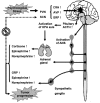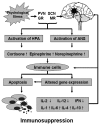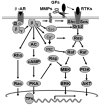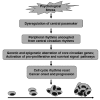Psychological aspect of cancer: From stressor to cancer progression
- PMID: 23136586
- PMCID: PMC3490404
- DOI: 10.3892/etm_00000003
Psychological aspect of cancer: From stressor to cancer progression
Abstract
Substantial evidence indicates that psychological stress can influence the incidence and progression of cancers, and adequate psychotherapies are beneficial to cancer patients. Recently, the mechanisms responsible for the effects of psychological stress on cancer cells have been extensively investigated at the systemic, biochemical and molecular levels. Accumulating data indicate that the effects of psychological stress on cancer cells are mainly mediated by key stress-related mediators and their corresponding receptors in multi-fold pathways: chronic stressors act on the paraventricular nucleus and the suprachiasmatic nuclei. The effects are then transmitted through the sympathetic nervous system and the hypothalamic-pituitary-adrenal axis, amplified by the unchecked release of stress-related mediators and altered behaviors. These mediators act as immunosuppressors or mitogens in the tumor microenvironment. The converging effects of psychological stress on cancer cells finally signal through receptors of the stress mediators and cytokines to activate the intracellular pro-proliferative and pro-migratory signaling pathways, and reset the molecular clock in tumor cells. Understanding these action mechanisms of psychological stress in promoting the growth and invasion of cancer cells is crucial for devising effective interventions.
Figures





Similar articles
-
[Role of the neurohypophysis in psychological stress].Encephale. 2001 May-Jun;27(3):245-59. Encephale. 2001. PMID: 11488255 Review. French.
-
Chronic Stress: Impacts on Tumor Microenvironment and Implications for Anti-Cancer Treatments.Front Cell Dev Biol. 2021 Nov 19;9:777018. doi: 10.3389/fcell.2021.777018. eCollection 2021. Front Cell Dev Biol. 2021. PMID: 34869378 Free PMC article. Review.
-
Molecular Mechanisms Underlying Psychological Stress and Cancer.Curr Pharm Des. 2016;22(16):2389-402. doi: 10.2174/1381612822666160226144025. Curr Pharm Des. 2016. PMID: 26916018 Review.
-
Systemic apomorphine alters HPA axis responses to interleukin-1 beta administration but not sound stress.Psychoneuroendocrinology. 2003 Aug;28(6):715-32. doi: 10.1016/s0306-4530(02)00065-3. Psychoneuroendocrinology. 2003. PMID: 12812860
-
Cytokines, prostaglandins and nitric oxide in the regulation of stress-response systems.Pharmacol Rep. 2013;65(6):1655-62. doi: 10.1016/s1734-1140(13)71527-5. Pharmacol Rep. 2013. PMID: 24553014 Review.
Cited by
-
Chronic stress-induced cholesterol metabolism abnormalities promote ESCC tumorigenesis and predict neoadjuvant therapy response.Proc Natl Acad Sci U S A. 2025 Feb 4;122(5):e2415042122. doi: 10.1073/pnas.2415042122. Epub 2025 Jan 27. Proc Natl Acad Sci U S A. 2025. PMID: 39869796 Free PMC article.
-
Multi-Dimensional Scaling Analysis of Key Regulatory Genes in Prostate Cancer Using the TCGA Database.Genes (Basel). 2021 Aug 29;12(9):1350. doi: 10.3390/genes12091350. Genes (Basel). 2021. PMID: 34573332 Free PMC article.
-
Norepinephrine Reduces Reactive Oxygen Species (ROS) and DNA Damage in Ovarian Surface Epithelial Cells.J Bioanal Biomed. 2015;7(3):75-80. doi: 10.4172/1948-593X.1000127. J Bioanal Biomed. 2015. PMID: 26167254 Free PMC article.
-
Stress alters the expression of cancer-related genes in the prostate.BMC Cancer. 2017 Sep 5;17(1):621. doi: 10.1186/s12885-017-3635-4. BMC Cancer. 2017. PMID: 28874141 Free PMC article.
-
Chronic Stress Effects on Tumor: Pathway and Mechanism.Front Oncol. 2021 Dec 20;11:738252. doi: 10.3389/fonc.2021.738252. eCollection 2021. Front Oncol. 2021. PMID: 34988010 Free PMC article. Review.
References
-
- Riley V. Mouse mammary tumors: alteration of incidence as apparent function of stress. Science. 1975;189:465–467. - PubMed
-
- Massie MJ. Prevalence of depression in patients with Cancer. J Natl Cancer Inst Monogr. 2004;32:57–71. - PubMed
-
- Garssen B. Psychological factors and cancer development: evidence after 30 years of research. Clin Psychol Rev. 2004;24:315–338. - PubMed
LinkOut - more resources
Full Text Sources
